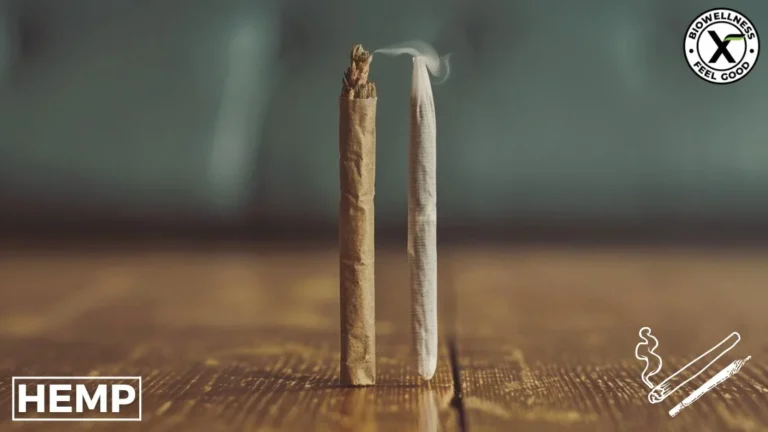key points
With the rise of cannabis companies and dispensaries, ready-to-smoke options are now available, alleviating the need for manual preparation and offering a wider range of choices. Pre-rolled joints, commonly referred to as “rolls,” have emerged as a convenient alternative for cannabis smokers. This convenience factor is particularly appealing when one desires to indulge in smoking without the hassle of preparation.
For those who are new to smoking cannabis, pre-rolled joints can generally be categorized into three main types: joints, blunts, and spliffs. Each type is characterized by its content, specifically the ratio of cannabis to tobacco, as well as the rolling material used, such as tobacco or hemp. Distinguishing between joints, blunts, and spliffs may be perplexing for beginners. Taking the time to understand the differences between these types can lead to a more satisfying experience when visiting a dispensary.
It’s worth noting that these terms are informal and may vary among different cannabis smokers and dispensaries. Below, we provide a breakdown of the two main types of pre-rolled joints and their advantages.
Spliff vs. Joints
Because joints and spliffs have unique properties, it is essential to analyze them individually for a comprehensive understanding.
What is a Joint?
A joint, a staple in cannabis culture, is distinguished by its composition solely of cannabis without any tobacco. Widely used for both recreational and medical consumption, joints offer a pure cannabis experience. Rolling papers for joints come in diverse thicknesses and often offer flavored options to tailor the smoking experience.
While health risks associated with smoking joints primarily stem from cannabis use, including potential respiratory issues and psychoactive effects, the process of rolling a joint involves grinding dried cannabis flower, rolling it into a paper, and sealing it, omitting the inclusion of tobacco altogether.
What is a Spliff?
A spliff is a cannabis cigarette rolled in tobacco paper, typically comprised of a blend of cannabis and tobacco, favored by smokers seeking the combined effects of both substances. The addition of tobacco alters the smoking experience, imparting a distinct flavor profile and possibly intensifying the psychoactive effects of cannabis. Thin rolling papers are often preferred by spliff enthusiasts to facilitate the mixture of cannabis and tobacco.
However, health risks associated with smoking spliffs encompass those linked to both cannabis and tobacco consumption, including respiratory issues and nicotine dependence. Rolling a spliff involves the process of combining dried cannabis flower with tobacco and rolling the blend into a thin paper, akin to the technique used for rolling joints.
Similarities between Spliffs and Joints:
Spliffs and joints exhibit various similarities:
- Rolling Material: Both are crafted using rolling papers instead of cigar wraps, such as those found in Swisher Sweets cigars. These papers are typically made from wood pulp, hemp, or rice and are available in different thicknesses to suit personal preference. Flavored options are also accessible for those desiring added taste.
- Cannabis Content: Both contain dried cannabis flowers.
- Paper Filters: Each can incorporate a paper filter, commonly known as a crutch, to prolong the smoking experience and prevent inhalation of plant material.
- Size: Both are generally comparable in size to a tobacco cigarette.
- Portability: Like cigarettes, they are convenient to carry and smoke while on the move.
- Appearance: Spliffs and joints can be indistinguishable, making it important to confirm what is being passed around in social settings before partaking.
- Rolling Technique: The process of rolling both spliffs and joints is similar and may require practice to master.
Differences between Spliffs and Joints
Spliffs and joints have clear distinctions. Here are the key differences:
- The main difference between a spliff and a joint lies in the inclusion of tobacco. While spliffs include cannabis mixed with tobacco, joints consist solely of cannabis.
- Spliffs introduce the potential health risks associated with smoking tobacco, including nicotine addiction and exposure to carcinogens found in tobacco smoke.
- Joints offer a pure cannabis experience, allowing users to enjoy the psychoactive effects of cannabis without the addition of nicotine or tobacco-related health concerns.
- Personal preference plays a significant role in choosing between a spliff and a joint, with some individuals preferring the combined effects of cannabis and tobacco in a spliff, while others opt for the purity of a cannabis-only joint.
Rolling Papers and Their Impact
The choice of rolling papers can significantly affect the smoking experience. Joints and spliffs can be rolled using various types of papers:
Thin Rolling Paper: Commonly used for joints to ensure a smooth and even burn. They are usually made of rice paper or hemp.
Thick Papers: Often used for spliffs, as they can better handle the mixed contents of tobacco and cannabis.
Flavored Papers: These add distinct flavor additives to the smoking experience, available in both joint and spliff rolling.
Health Risks and Concerns
Smoking Joints
Smoking pure cannabis in a joint avoids the health risks associated with tobacco. However, smoking any substance can pose health risks, including respiratory issues. Medical cannabis users often prefer joints for their clean, unadulterated cannabis experience.
Smoking Spliffs
Smoking spliffs introduces additional health risks due to the inclusion of tobacco. Tobacco smoke contains numerous harmful chemicals and is associated with nicotine addiction, respiratory problems, and increased risk of cancer. Spliff smokers face the same health risks as cigarette smokers due to the presence of tobacco.
Cultural and Personal Preferences
Cannabis culture varies globally, and the preference for joints or spliffs often depends on regional practices and personal preferences. In Europe, spliffs are more common, while in North America, joints are typically preferred.
Psychoactive Effects
The psychoactive effects of cannabis can be influenced by the presence of tobacco. Spliffs can provide a quicker, more intense high due to the nicotine, which can also lead to nicotine dependence. Joints offer a more traditional cannabis high without the influence of tobacco.
Flavor and Smoking Experience
The distinct flavor of a spliff comes from the combination of cannabis and tobacco. Some users enjoy this mix for the nuanced taste and the slower burn rate. Joints, however, provide the pure flavor of cannabis, which is often preferred by connoisseurs looking for the true taste of the cannabis flower.
Practical Considerations
Rolling Techniques
Rolling a joint or a spliff requires different techniques and materials:
Rolling Trays and Rollers: Helpful tools for both methods, ensuring a uniform and well-constructed product.
Pre-Rolled Joints: Convenient for those who prefer not to roll their own joints. Pre-rolls typically contain pure cannabis.
Blunt Wraps and Cigar Wraps: Used for rolling blunts, which are similar to spliffs but use a tobacco leaf wrap instead of rolling paper.
Burn Rate and Consumption
Spliffs tend to burn slower due to the tobacco content, allowing for a longer smoke session. Joints burn uniformly but can be consumed more quickly, making them ideal for short, intense smoking sessions.
Health and Legal Considerations
Medical Cannabis Users
For medical cannabis users, smoking joints is often preferred to avoid the health risks associated with tobacco. Holding a medical cannabis card can provide access to high-quality cannabis products, including pre-rolled joints.
Health Concerns
Both joints and spliffs carry health concerns related to smoking. While joints avoid the risks associated with tobacco, they still pose risks to lung health. Spliffs introduce additional concerns due to the harmful effects of tobacco and nicotine addiction.
Final thoughts: What will be your choice, Joints or Spliffs?
Choosing between a spliff or a joint depends on personal preference, health considerations, and cultural influences. Joints offer a pure cannabis experience with fewer health risks, while spliffs provide a unique flavor and smoking sensation due to the inclusion of tobacco. Understanding the differences between these methods can help users make informed decisions about their cannabis consumption. Whether opting for a joint or a spliff, it’s important to be aware of the health implications and enjoy cannabis responsibly.

Legal Disclaimer:
By reading this information presented, you agree to release the author of any liability that comes from using this data. This post contains no legal advice. Claims about cannabinoids have not yet been approved by the FDA. Cannabis laws and regulations are subject to change. Read the full legal disclaimer here.
Other Topics You Might Want To Read:
- Delta-8 vs. Delta-10 For Pain: Which Works The Best?
- CBD for Vertigo – Discover the Potential
- Finding the Best CBN Gummies for Sleep Support
- What Are the Best Forms of CBN Available Today?
- Organic 50mg Delta-8 Gummies: Benefits and Effects
- CBG and CBD: Differences and Similarities
- What is Full Spectrum THC?
- 100mg Delta-8 THC Gummies Review From BioWellnessX
- Delta 8 Edibles Review And Where to Buy Them!
- Is Delta-8 or CBD Better For Pain? The Top 5 Differences!
References:
- Cannabidiol and Intestinal Motility
- Delta-8-THC: Delta-9-THC’s nicer younger sibling?
- Consumer Experiences with Delta-8-THC
- Hemp Production and the 2018 Farm Bill – 07/25/2019 | FDA
- The Controlled Substances Act (dea.gov)
FAQs About Spliffs and Joints
Rolling papers for joints come in various sizes and materials, including traditional, unbleached, hemp, and rice papers. Some are flavored. Adding a crutch or filter made from folded cardstock can provide extra durability to the joint’s mouthpiece.
Spliff smoking produces unique effects due to the interaction of the active ingredients in tobacco and cannabis.
Blunts are a close relative to a joint. A blunt is rolled by emptying a pre-rolled cigar or cigarillo — which is typically made with a tobacco leaf — and filling it with cannabis. Alternatively, you can use blunt wraps. They’re typically bigger than joints and shared between a few smokers.
Most rolling papers have flavor only on the gum line, which limits the amount of flavor that comes into contact with your mouth. Some brands, however, put distinct flavor additives across the whole paper. With these rolling papers, the flavors will come through in the smoke as well, taking your smoking session to a whole new level.
The main quality of a good paper is that they don’t tear, seal seamlessly, handle well between your fingers, and burn uniformly.







